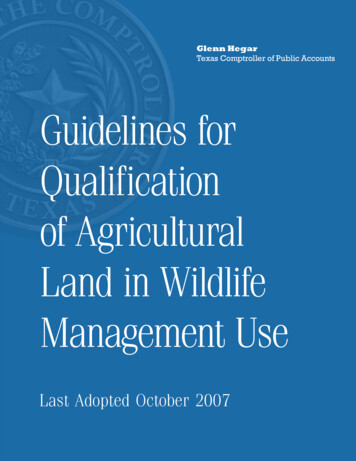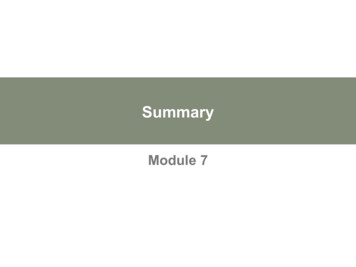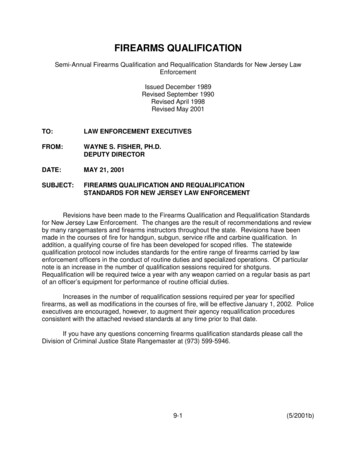
Transcription
Glenn HegarTexas Comptroller of Public AccountsGuidelines forQualificationof AgriculturalLand in WildlifeManagement UseLast Adopted October 2007
B — Guidelines for Qualification of Agricultural Land in Wildlife Management UseJanuary 2018
Texas Property TaxTable of ContentsIntroduction . . . . . . . . . . . . . . . . . . . . . . . . . . . . . . . . . . . . . . . . . . . . . . . .1Part I: Qualifying Land for Wildlife Management Use . . . . . . . . . . . . . . . . . . . . . .3Agricultural Use Requirements . . . . . . . . . . . . . . . . . . . . . . . . . . . . . . . . . . . . . .4Wildlife Management Use Requirements . . . . . . . . . . . . . . . . . . . . . . . . . . . . . . . .Part II: Wildlife Management Activities, Practices and Definitions . . . . . . . . . . . . . .Wildlife Management Plan . . . . . . . . . . . . . . . . . . . . . . . . . . . . . . . . . . . . . . . .Habitat Control (Habitat Management) . . . . . . . . . . . . . . . . . . . . . . . . . . . . . . . . . .3778Erosion Control . . . . . . . . . . . . . . . . . . . . . . . . . . . . . . . . . . . . . . . . . . . . . .10Providing Supplemental Water . . . . . . . . . . . . . . . . . . . . . . . . . . . . . . . . . . . . . .11Predator Management . . . . . . . . . . . . . . . . . . . . . . . . . . . . . . . . . . . . . . . . . . .11Providing Supplemental Food . . . . . . . . . . . . . . . . . . . . . . . . . . . . . . . . . . . . . .12Census Counts . . . . . . . . . . . . . . . . . . . . . . . . . . . . . . . . . . . . . . . . . . . . . .14Providing Supplemental Shelter . . . . . . . . . . . . . . . . . . . . . . . . . . . . . . . . . . . . .For More Information . . . . . . . . . . . . . . . . . . . . . . . . . . . . . . . . . . . . . . . . . . .January 20181314Guidelines for Qualification of Agricultural Land in Wildlife Management Use — i
ii — Guidelines for Qualification of Agricultural Land in Wildlife Management UseJanuary 2018
Texas Property TaxIntroductionThese Guidelines for Qualification of Agricultural Land inWildlife Management Use will discuss the requirements thatland must meet to qualify for wildlife management use, howto value this land, and each of the seven wildlife managementactivities mandated by state law.In 1995, Texas voters approved Proposition 11, which amended Article VIII, Section 1-d-1 of the Texas Constitution topermit agricultural appraisal for land used to manage wildlife. H.B. 1358 implemented the constitutional amendment bymaking wildlife management an agricultural use that qualifies the land for agricultural appraisal.In 2001, the Legislature passed H.B. 3123, requiring the Texas Parks and Wildlife Department (TPWD) to develop andthe Comptroller to adopt rules for the qualification of agricultural land in wildlife management use. These guidelines andChapter 9, Subchapter F of the Texas Administrative Codeconstitute the rules, as required by Section 23.52(g), TaxCode. The Texas Administrative Code language specificallyaddresses qualification of land partitioned from a previouslyqualified larger tract of real property qualified for 1-d-1 appraisal as wildlife management land.Tax Code Chapter 23, Subchapter D addresses the requirements for landowners to qualify their land for agriculturalappraisal and also instructs county appraisal districts in howto appraise qualified agricultural land. Land used for wildlife management must meet all the legal requirements of landqualified for agricultural appraisal. Those requirements, however, are outside the scope of these guidelines. The Comptroller publishes a Manual for the Appraisal of Agricultural Landthat discusses in detail the qualification of land for agricultural appraisal, the rollback tax penalty for change of use andappraisal of agricultural land.11To obtain a copy of Manual for the Appraisal of Agricultural Land,please write the Comptroller, Property Tax Division, P. O. Box 13528,Austin, Texas 78711-3528.January 2018Land on which the owner engages in wildlife managementand that meets other requirements for agricultural appraisalis qualified for agricultural appraisal and is technically in agricultural use. To simplify terms, however, this booklet refersto agricultural land used for wildlife management as land inwildlife management use.Tax Code Section 23.51(1) defines qualified agricultural land as:Land that is currently and principally devoted to agricultural use to the degree of intensity typical for thearea and has been used for agriculture or timber for atleast five of the preceding seven years.2Section 23.51(2) Tax Code includes wildlife management inthe definition of agricultural uses of land. Section 23.51(7)Tax Code defines wildlife management as:Actively using land that at the time the wildlife management began was appraised as qualified open-space landunder this subchapter in at least three of the followingways to propagate a sustaining breeding, migrating, orwintering population of indigenous wild animals forhuman use, including food, medicine, or recreation:A.B.C.D.E.F.G.habitat control;erosion control;predator control;providing supplemental supplies of water;providing supplemental supplies of food;providing shelters; andmaking census counts to determine population.Part One discusses the qualification of agricultural land usedfor wildlife management. Part Two discusses in detail the seven wildlife management activities listed in Section 23.51(7).2Land qualified for timber appraisal is not eligible for wildlife managementuse. See discussion on page 3.Guidelines for Qualification of Agricultural Land in Wildlife Management Use — 1
2 — Guidelines for Qualification of Agricultural Land in Wildlife Management UseJanuary 2018
Texas Property TaxPart I:Qualifying Land for WildlifeManagement UseWildlife Management UseRequirementsLand must be qualified for Chapter 23,Subchapter D (1-d-1) Agricultural AppraisalThe first requirement for wildlife management use qualification is purely technical and is not related to the land’s actualuse to manage wildlife. The law restricts the land that mayqualify for wildlife management use. To qualify for agricultural appraisal under the wildlife management use, landmust be qualified for agricultural appraisal under Tax CodeChapter 23, Subchapter D, (also called 1-d-1 or open spaceagricultural appraisal), at the time the owner changes use towildlife management use.In other words, the land must have been qualified and appraised as agricultural land during the year before the yearthe owner changes to the wildlife management use. For example, an owner who wishes to qualify for wildlife management use in 2002 must be able to show the land was qualifiedfor and appraised as agricultural land in 2001.Land qualified for timber appraisal is not eligible to qualifyfor wildlife management use. Timber land is qualified underTax Code Chapter 23, Subchapter E. The law limits wildlife management use to land qualified under Subchapter Dof Chapter 23. Similarly, land qualified for agricultural appraisal under Article VIII, Section 1-d of the Texas Constitution and Chapter 23, Subchapter C Tax Code (also called 1-dagricultural appraisal) is not ineligible for wildlife management use.January 2018Land must be used to generate a sustainingbreeding, migrating or wintering population ofindigenous wild animals.The second requirement for qualified wildlife managementuse is that the land must be used to propagate a sustainingbreeding, migrating or wintering population of indigenouswild animals.An indigenous animal is a native animal that originated in ornaturally migrates through an area and that is living naturallyin that area, as opposed to an exotic animal or one that hasbeen introduced to the area. In this context, an indigenousanimal is one that is native to Texas. (Contact TPWD to determine if an animal species is considered indigenous.)Land may qualify for wildlife management use if it is instrumental in supporting a sustaining breeding, migratingor wintering population. A group of animals need not permanently live on the land, provided they regularly migrateacross it or seasonally live there.A sustaining breeding population is a group of indigenouswild animals that is large enough to live independently overseveral generations. This definition implies that the population will not die out because it produces enough animals tocontinue as a viable group. TPWD may be able to provideinformation to help determine the number of animals of aparticular species that must group together to sustain thepopulation.A migrating population of indigenous wild animals is agroup of animals moving between seasonal ranges. A wintering population of indigenous wild animals is a group ofanimals living on its winter range.Guidelines for Qualification of Agricultural Land in Wildlife Management Use — 3
The indigenous wildlife population must beproduced for human use.The law requires an owner to propagate the wildlife population for human use. Human use may include food, medicineor recreation. Land will not qualify unless the owner propagates the population of wild animals for a human purpose.The use of animals for food and medicine is self-explanatory.These uses result in a product and require active participation. A recreational use may be either active or passive andmay include any type of use for pleasure or sport. Bird watching, hiking, hunting, photography and other non-passive recreational or hobby-type activities are qualifying recreationaluses. The owner’s passive enjoyment in owning the land andmanaging it for wildlife also is a qualifying recreational use.Is the land used for three or more ofthe following activities?Under the law, an owner must perform at least three of sevenlisted wildlife management activities on the land. An ownermay qualify by doing more than three, but may not engagein fewer than three of the activities. These activities are explained in detail in Part Two of this booklet, but a short summary of each management activity listed in the law appearsbelow. Habitat Control (Habitat Management). A wild animal’s habitat is its surroundings as a whole, includingplants, ground cover, shelter and other animals on theland. Habitat control—or habitat management—means actively using the land to create or promote an environmentthat is beneficial to wildlife. Erosion Control. Any active practice that attempts to reduce or keep soil erosion to a minimum for the benefit ofwildlife is erosion control. Predator Control (Predator Management). This termmeans practices intended to manage the population ofpredators to benefit the owner’s target wildlife population. Predator control is usually not necessary unless thenumber of predators is harmful to the desired wildlifepopulation. Providing Supplemental Supplies of Water. Naturalwater exists in all wildlife environments. Supplementalwater is provided when the owner actively provides waterin addition to the natural sources. Providing Supplemental Supplies of Food. Most wildlife environments have some natural food. An ownersupplies supplemental food by providing food or nutritionin addition to the level naturally produced on the land. Providing Shelter. This term means actively creating ormaintaining vegetation or artificial structures that provideshelter from the weather, nesting and breeding sites or escape cover from enemies. Making Census Counts to Determine Population. Census counts are periodic surveys and inventories to determine the number, composition or other relevant information about a wildlife population to measure if the currentwildlife management practices are serving the targetedspecies.Agricultural Use RequirementsChief appraisers should remember that an owner’s wildlifemanagement use must meet all the requirements to qualifyfor agricultural use, defined in Tax Code Section 23.51(1).Below is a brief discussion of the principal issues involved inagricultural use of land used for wildlife management. For athorough discussion of these components, please refer to theManual for the Appraisal of Agricultural Land.Primary UseThe law requires agriculture to be the primary use of theland. Wildlife management is an agricultural use under thelaw. The primary use requirement is particularly importantfor land used to manage wildlife. For example, land devotedto wildlife management can be used as a residence for theowner, but the land will not qualify if residential use—andnot wildlife management—is the land’s primary use.A chief appraiser must gather and consider all the relevantfacts to determine if the land is primarily used to managewildlife. Some important questions are listed below. Is the owner implementing an active, written, wildlifemanagement plan that shows he or she is engaging inactivities necessary to preserve a sustaining breedingpopulation on the land? An owner’s management plan isrequired and must be completed on a form supplied byTPWD for each tract of land for which qualification issought. A plan is clear evidence of the owner’s use of theland primarily for wildlife management. A good plan willusually list wildlife management activities with the appropriate seasons and/or sequence of events.4 — Guidelines for Qualification of Agricultural Land in Wildlife Management UseJanuary 2018
Do the owner’s management practices emphasize managing the population to ensure its continued existence overanother use of the land? For example, does the owner refrain from allowing visitors on the land in years when thehabitat is sensitive? Has the owner engaged in the wildlife management practices necessary to sustain and encourage the population?In some cases, an owner must control predators and supply water when water is not adequate, supply shelter andfood when natural food production is not adequate andestablish vegetation to control erosion. In other cases,less active management may maintain and encourage thegrowth of wildlife. Are there improvements—appropriate fencing, for example—necessary to control or sustain the wildlifepopulation?Because wildlife management activities are elements of thedegree of intensity determination, an owner must be engagingin three of seven activities to the degree of intensity typicalfor the area. General principles of the degree of intensity testare discussed in the Manual for the Appraisal of AgriculturalLand. TPWD has developed regional wildlife managementplans detailing specific management activities appropriatefor each ecological area. (See page 8.)An owner may use land for purposes that are secondary to theprimary use—wildlife management—if the secondary use iscompatible with the primary use. For example, an owner mayengage in wildlife management and also operate a businessin which bird watchers stay on the land overnight and watchfor birds during the day (known as a bird and breakfast operation). This activity is secondary to the primary activityof managing the wildlife, but it is not incompatible with thewildlife management use. General principles of primary andsecondary use are discussed in the Manual for the Appraisalof Agricultural Land.Determining Appraised ValuesDegree of Intensity for WildlifeManagement UseThe degree-of-intensity standard for wildlife managementland is determined in the same way as other agriculturaluses. Wildlife management land usually requires management practices that encourage long-term maintenance of thepopulation.A chief appraiser may ask questions such as whether fencingis typical in the area for managing the target wildlife population, and what is the typical population size? In addition,the chief appraiser should ask how many of the following activities are typical in the area (or typical for the area duringsome parts of the year): habitat management; predator management; erosion control; providing supplemental suppliesof food or water; providing shelter; and engaging in censuscounts.January 2018Historical Use RequirementLand must have qualified for 1-d-1 agricultural use and beenappraised as 1-d-1 agricultural use in the year before theowner changes its use to wildlife management. Consequently,the time-period test to determine if the land has been usedfor agriculture for five of the preceding seven years usuallyis not necessary.The wildlife management use is a revenue-neutral use ofland. The owner who switches from another agricultural useto wildlife management use must pay the same amount ofproperty taxes that would have been paid if the land had remained in its former agricultural use.Land qualified for wildlife management should be placed ina wildlife management category, but should have the sameappraised value as before its conversion to wildlife management use. For example, if the land was in Irrigated CroplandI before the owner switched its use to wildlife management,the land should be placed in the wildlife management category, but will be appraised at the Irrigated Cropland I value.If that land use category’s value subsequently changes in thecounty, the new category values would apply to those tractsunder wildlife management use in that category.Notifying the Chief Appraiser of Changeto Wildlife Management UseThe law does not require an annual application for agricultural use once the land has qualified. Because only 1-d-1qualified land may qualify for wildlife management use, anowner who changes to this use need not reapply for agricultural appraisal. The law, however, does require an owner whochanges the category of agricultural use to notify the chiefappraiser of the change.Guidelines for Qualification of Agricultural Land in Wildlife Management Use — 5
When an owner changes agricultural uses to wildlife management, the owner must notify the chief appraiser in writingbefore May 1 of the year in which the owner wants to qualifyunder wildlife management use. The chief appraiser then willdetermine if the land qualifies for wildlife management use.Likewise, an owner must notify the chief appraiser if land isswitched from wildlife management use to another qualifying agricultural use.Owners should contact their county appraisal districts aboutnotification requirements before changing small portions oftheir land from one qualified agricultural use to another. Forexample, if an owner converts a part of a 1,000-acre farm towildlife management use by creating a pond for wildlife, theowner should ask about the appraisal district’s need for notification and documentation requirements.6 — Guidelines for Qualification of Agricultural Land in Wildlife Management UseJanuary 2018
Texas Property TaxPart II:Wildlife Management Activities,Practices and DefinitionsAmong the statutory requirements for property owners toqualify their agricultural land for wildlife management use isa mandate that owners perform at least three of seven wildlife management activities, which were briefly summarizedin Part I:1.2.3.4.5.6.7.habitat control (habitat management);erosion control;predator control (predator management);providing supplemental supplies of water;providing supplemental supplies of food;providing shelters; andmaking census counts to determine population.Below is a detailed explanation of the kinds of practices thatchief appraisers should examine to determine if propertyowners are satisfying the law’s requirements. Some of thepractices listed may require permits from federal, state or local governments. For example, before improving a wetland orcontrolling grackles or cowbirds, an owner may need a permit. Or before a planned burning, an owner may be requiredto provide a map of the acreage. Property owners should contact the appropriate legal authorities for permit informationif they have any questions or concerns about engaging in anyof the practices listed above.Wildlife Management PlanA Wildlife Management Plan gives information on the property’s history and current use, establishes landowner goalsfor the property and provides a set of activities designed tointegrate wildlife and habitat improvement. Such a plan isclear evidence that the owner’s use of the land is primarilyfor wildlife management.January 2018As stated in Part 1, an owner must provide a wildlife management plan to the appraisal district. The plan must be completed on a TPWD form for each tract for which wildlifemanagement use qualification is sought. The activities andpractices contained in the plan must be consistent with theactivities and practices recommended in the model TPWDregional management plan for the region in which the property is located.Landowners may formulate their own plans. Assistance orreview, however, is available from the TPWD, the Texas Agricultural Extension Service, the U.S. Department of Agriculture’s Natural Resource Conservation Service (NRCS), theTexas Forest Service or other qualified wildlife biologists.A complete plan is likely to include elements of all sevenlisted wildlife management activities. All activities and practices should be designed to overcome deficiencies that limitwildlife or harm their habitats. Each one of the activities listed in Part Two should be practiced routinely or consistentlyas part of an overall habitat management plan. For example,scattering seed corn sporadically would not qualify as providing supplemental supplies of food under these guidelines,and occasionally placing barrels of water in a pasture wouldnot meet the requirements for providing supplemental supplies of water.In addition, some activities that are appropriate for certain regions of Texas would be inappropriate in others. For example,some areas of East Texas may not require providing supplemental pond water for wildlife. And there may be no need forsupplemental cover in South Texas brush. TPWD has developed regional wildlife management plans, listing the activitiesappropriate to Texas’ 10 ecological regions. The regions are:Guidelines for Qualification of Agricultural Land in Wildlife Management Use — 7
1. East Texas Pineywoods2. Gulf Coast Prairies and Marshes3. Post Oak Savannah4. Blackland Prairies5. Cross Timbers and Prairies6. South Texas Plains7. Edwards Plateau8. Rolling Plains9. High Plains10. Trans-Pecos89Ecological Regionsof Texas91085741347326Habitat Control(Habitat Management)A wild animal’s habitat is its surroundings as a whole, including plants, ground cover, shelter and other animals onthe land. Habitat control—or habitat management—meansactively using the land to create or promote an environmentthat benefits wildlife on the land.Activities that contribute to habitat control or managementinclude: grazing management;prescribed burning;range enhancement;brush management;forest management; riparian management and improvement;wetland improvements;habitat protection for species of concern;managing native, exotic and feral species; andwildlife restoration.Grazing management means shifting livestock and grazing intensity to increase food and animal cover or to improvespecific animals’ habitat. Grazing management focuses on: the kind and class of livestock grazed; stocking rates; periodic rest for pastures by controlling grazing intensity;and/or the sign of excluding livestock from sensitive areas to promote vegetation protection and recovery or to eliminatecompetition for food and cover.8 — Guidelines for Qualification of Agricultural Land in Wildlife Management UseJanuary 2018
Deferred grazing can last up to two years. Seasonal stockeroperations also may be appropriate. Supplemental livestockwater—provided by earthen tanks or wells—may be usefulwhen implementing grazing rotation.Appropriately designed fencing can play an important role ingrazing rotation plans. Fencing also can be used to improveor protect sensitive areas, woodlands, wetlands, riparian areas and spring sites. Property owners should review theirfencing practices and grazing plans annually to ensure theymeet the overall wildlife management goals.Prescribed burning is defined as the planned application offire to improve habitat and plant diversity, to increase foodand cover or to improve particular species’ habitats. If theowner has a wildlife management plan, that plan should indicate the frequency of planned burnings and the minimumpercentage of acreage to be burned. A plan may designate theareas to be protected or excluded from burning, but shouldremain flexible during periods when conditions are not favorable for burning, such as during periods of drought.Range enhancement means to establish native plants—suchas grasses and forbs (weeds and wildflowers)—that providefood and cover for wildlife or help control erosion. Protecting, restoring and managing native prairies also is consideredrange enhancement.The plants chosen and the methods for establishing the plantsshould be appropriate to the county. Non-native species generally are not recommended, but if required for a specificpurpose, non-native species should not exceed 25 percent ofthe seeding mix.The seeding mixtures should provide for maximum nativeplant diversity. Many broadleaf plants, such as weeds andwildflowers, provide forage for wildlife and/or seed production. Owners should encourage weed and wildflower speciesby using the methods appropriate to native rangelands, landdevoted to the federal Conservation Reserve Program (CRP)and improved grass pastures (for example, Coastal Bermuda).Some periodic noxious weed control may be necessary infields converted to native rangeland to help establish desirable vegetation.Brush management may involve maintaining, establishingor selectively removing or suppressing targeted woody plantsJanuary 2018species (including exotics) to encourage the growth of desirable trees, shrubs, grasses and forbs for forage and nestingor protective cover for selected wildlife species. Brush management also includes keeping the proper kind, amount anddistribution of woody cover for particular species.A useful brush management plan should examine wildlifecover requirements, soil types, slope angle and direction, soilloss and erosion factors and plans to control reinvasion aspart of an overall wildlife management plan. This practicealso should focus on retaining snags to provide cover andnesting sites for cavity-nesting animals. In addition, herbicides, if used, should be used in strict accordance with labeldirections.In areas where brushy cover is limited, property ownersmay establish native tree and shrub species to provide food,corridors and/or shelter using appropriate plant species andmethods.Forest management involves establishing, maintaining, harvesting, selectively removing or suppressing trees or woodyspecies (including exotics) to allow for the growth of desirable trees, shrubs, grasses and forbs for forage and nestingor protective cover for selected species. Forest managementactivities also include keeping the proper kind, amount anddistribution of woody cover for selected animal species.As with brush management, this practice also includes retaining snags to provide cover and nesting sites for cavitynesting animals. Forest management activities include precommercial thinning or non-commercial thinning, whichinvolves reducing the stocking levels in a stand to increasethe sunlight that reaches the ground to increase vegetation orplants in the understory.Property owners should establish native tree and shrub species to provide food, corridors and/or shelter using speciesand methods appropriate to the county. Owners should attempt to restore important forested habitats including bottomland hardwoods, longleaf pine, bogs, mixed pine/hardwood areas and upland hardwoods. Owners also should avoidbreaking up large forested habitats for some wildlife species.Riparian management and improvement focuses on annually and/or seasonally protecting the vegetation and soils inriparian areas (low areas on either side of stream courses).Guidelines for Qualification of Agricultural Land in Wildlife Management Use — 9
Riparian management and improvements can include providing livestock alternate watering sites; deferring livestock grazing in pastures with riparian areas during critical periods; excluding livestock from pastures with riparian areas; and fencing to exclude or provide short-duration livestock grazing.Property owners should attempt to restore important forestedhabitats including bottomland hardwoods, bogs, mixed pine/hardwood areas and turkey roost sites and avoid breaking uplarge forested habitats in riparian areas.Wetland improvements provide seasonal or permanent water for roosting, feeding or nesting for wetland wildlife. Thispractice involves creating, restoring or managing shallowwetlands, greentree reservoirs, playa lakes and other moistsoil sites.Habitat protection for species of concern refers to managing land to provide habitat for an endangered, threatenedor rare species. Habitat protection includes managing or developing additional areas for protecting nesting sites, feedingareas and other critical habitat limiting factors. This protection can be provided by fencing off critical areas; managingvegetation for a particular species; maintaining firebreaks toensure critical overstory vegetation; and annually monitoringthe species of concern. Any broad-scale habitat managementfor migrating, wintering, breeding neotropical birds (primarily songbirds) should follow the specific guidelines providedin TPWD’s management plans for each ecological region.Contact TPWD or follow specifically approved managementguidelines before practicing act
Agricultural Use Requirements. Chief appraisers should remember that an owner's wildlife . management use must meet all the requirements to qualify for agricultural use, defined in Tax Code Section 23.51(1). Below is a brief discussion of the principal issues involved in agricultural use of land used for wildlife management . For a










